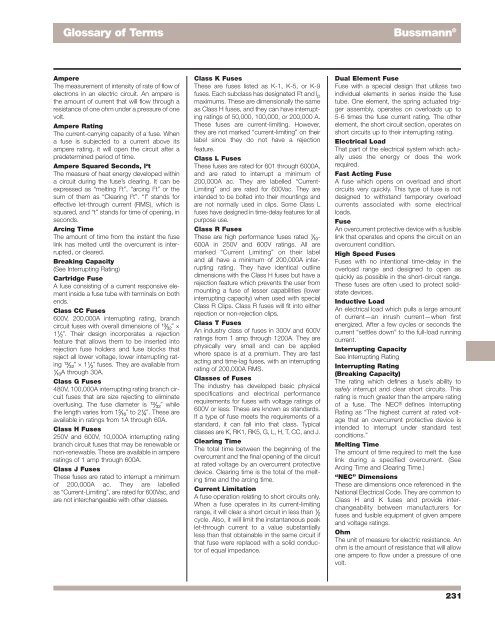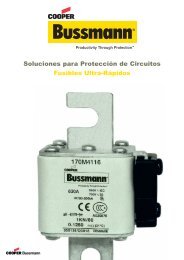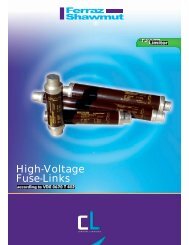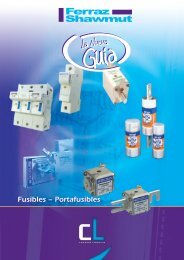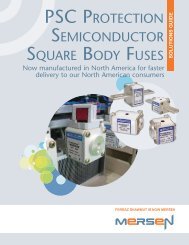Bussmann
You also want an ePaper? Increase the reach of your titles
YUMPU automatically turns print PDFs into web optimized ePapers that Google loves.
Glossary of Terms<br />
<strong>Bussmann</strong> ®<br />
Ampere<br />
The measurement of intensity of rate of flow of<br />
electrons in an electric circuit. An ampere is<br />
the amount of current that will flow through a<br />
resistance of one ohm under a pressure of one<br />
volt.<br />
Ampere Rating<br />
The current-carrying capacity of a fuse. When<br />
a fuse is subjected to a current above its<br />
ampere rating, it will open the circuit after a<br />
predetermined period of time.<br />
Ampere Squared Seconds, l 2 t<br />
The measure of heat energy developed within<br />
a circuit during the fuse’s clearing. It can be<br />
expressed as “melting l 2 t”, “arcing l 2 t” or the<br />
sum of them as “Clearing l 2 t”. “l” stands for<br />
effective let-through current (RMS), which is<br />
squared, and “t” stands for time of opening, in<br />
seconds.<br />
Arcing Time<br />
The amount of time from the instant the fuse<br />
link has melted until the overcurrent is interrupted,<br />
or cleared.<br />
Breaking Capacity<br />
(See Interrupting Rating)<br />
Cartridge Fuse<br />
A fuse consisting of a current responsive element<br />
inside a fuse tube with terminals on both<br />
ends.<br />
Class CC Fuses<br />
600V, 200,000A interrupting rating, branch<br />
circuit fuses with overall dimensions of ⁄‹Ω£∑ ≈<br />
1⁄Ω∑. Their design incorporates a rejection<br />
feature that allows them to be inserted into<br />
rejection fuse holders and fuse blocks that<br />
reject all lower voltage, lower interrupting rating<br />
⁄‹Ω£∑ ≈ 1⁄Ω∑ fuses. They are available from<br />
⁄Ω¡ºA through 30A.<br />
Class G Fuses<br />
480V, 100,000A interrupting rating branch circuit<br />
fuses that are size rejecting to eliminate<br />
overfusing. The fuse diameter is ⁄‹Ω£∑ while<br />
the length varies from 1fiΩ¡§∑ to 2⁄Ω¢∑. These are<br />
available in ratings from 1A through 60A.<br />
Class H Fuses<br />
250V and 600V, 10,000A interrupting rating<br />
branch circuit fuses that may be renewable or<br />
non-renewable. These are available in ampere<br />
ratings of 1 amp through 600A.<br />
Class J Fuses<br />
These fuses are rated to interrupt a minimum<br />
of 200,000A ac. They are labelled<br />
as “Current-Limiting”, are rated for 600Vac, and<br />
are not interchangeable with other classes.<br />
Class K Fuses<br />
These are fuses listed as K-1, K-5, or K-9<br />
fuses. Each subclass has designated I 2 t and l p<br />
maximums. These are dimensionally the same<br />
as Class H fuses, and they can have interrupting<br />
ratings of 50,000, 100,000, or 200,000 A.<br />
These fuses are current-limiting. However,<br />
they are not marked “current-limiting” on their<br />
label since they do not have a rejection<br />
feature.<br />
Class L Fuses<br />
These fuses are rated for 601 through 6000A,<br />
and are rated to interrupt a minimum of<br />
200,000A ac. They are labelled “Current-<br />
Limiting” and are rated for 600Vac. They are<br />
intended to be bolted into their mountings and<br />
are not normally used in clips. Some Class L<br />
fuses have designed in time-delay features for all<br />
purpose use.<br />
Class R Fuses<br />
These are high performance fuses rated ⁄Ω¡º-<br />
600A in 250V and 600V ratings. All are<br />
marked “Current Limiting” on their label<br />
and all have a minimum of 200,000A interrupting<br />
rating. They have identical outline<br />
dimensions with the Class H fuses but have a<br />
rejection feature which prevents the user from<br />
mounting a fuse of lesser capabilities (lower<br />
interrupting capacity) when used with special<br />
Class R Clips. Class R fuses will fit into either<br />
rejection or non-rejection clips.<br />
Class T Fuses<br />
An industry class of fuses in 300V and 600V<br />
ratings from 1 amp through 1200A. They are<br />
physically very small and can be applied<br />
where space is at a premium. They are fast<br />
acting and time-lag fuses, with an interrupting<br />
rating of 200,000A RMS.<br />
Classes of Fuses<br />
The industry has developed basic physical<br />
specifications and electrical performance<br />
requirements for fuses with voltage ratings of<br />
600V or less. These are known as standards.<br />
If a type of fuse meets the requirements of a<br />
standard, it can fall into that class. Typical<br />
classes are K, RK1, RK5, G, L, H, T, CC, and J.<br />
Clearing Time<br />
The total time between the beginning of the<br />
overcurrent and the final opening of the circuit<br />
at rated voltage by an overcurrent protective<br />
device. Clearing time is the total of the melting<br />
time and the arcing time.<br />
Current Limitation<br />
A fuse operation relating to short circuits only.<br />
When a fuse operates in its current-limiting<br />
range, it will clear a short circuit in less than ⁄Ω<br />
cycle. Also, it will limit the instantaneous peak<br />
let-through current to a value substantially<br />
less than that obtainable in the same circuit if<br />
that fuse were replaced with a solid conductor<br />
of equal impedance.<br />
Dual Element Fuse<br />
Fuse with a special design that utilizes two<br />
individual elements in series inside the fuse<br />
tube. One element, the spring actuated trigger<br />
assembly, operates on overloads up to<br />
5-6 times the fuse current rating. The other<br />
element, the short circuit section, operates on<br />
short circuits up to their interrupting rating.<br />
Electrical Load<br />
That part of the electrical system which actually<br />
uses the energy or does the work<br />
required.<br />
Fast Acting Fuse<br />
A fuse which opens on overload and short<br />
circuits very quickly. This type of fuse is not<br />
designed to withstand temporary overload<br />
currents associated with some electrical<br />
loads.<br />
Fuse<br />
An overcurrent protective device with a fusible<br />
link that operates and opens the circuit on an<br />
overcurrent condition.<br />
High Speed Fuses<br />
Fuses with no intentional time-delay in the<br />
overload range and designed to open as<br />
quickly as possible in the short-circuit range.<br />
These fuses are often used to protect solidstate<br />
devices.<br />
Inductive Load<br />
An electrical load which pulls a large amount<br />
of current—an inrush current—when first<br />
energized. After a few cycles or seconds the<br />
current “settles down” to the full-load running<br />
current.<br />
Interrupting Capacity<br />
See Interrupting Rating<br />
Interrupting Rating<br />
(Breaking Capacity)<br />
The rating which defines a fuse’s ability to<br />
safely interrupt and clear short circuits. This<br />
rating is much greater than the ampere rating<br />
of a fuse. The NEC ® defines Interrupting<br />
Rating as “The highest current at rated voltage<br />
that an overcurrent protective device is<br />
intended to interrupt under standard test<br />
conditions.”<br />
Melting Time<br />
The amount of time required to melt the fuse<br />
link during a specified overcurrent. (See<br />
Arcing Time and Clearing Time.)<br />
“NEC” Dimensions<br />
These are dimensions once referenced in the<br />
National Electrical Code. They are common to<br />
Class H and K fuses and provide interchangeability<br />
between manufacturers for<br />
fuses and fusible equipment of given ampere<br />
and voltage ratings.<br />
Ohm<br />
The unit of measure for electric resistance. An<br />
ohm is the amount of resistance that will allow<br />
one ampere to flow under a pressure of one<br />
volt.<br />
231


